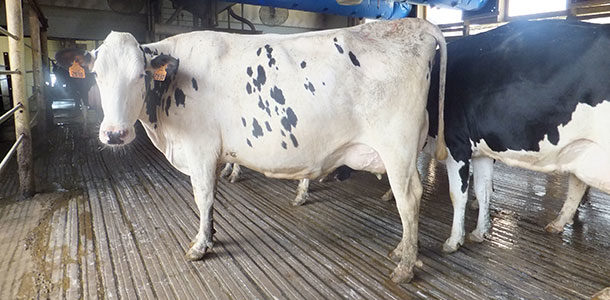A new concept in holding area cooling is taking the edge off of heat stress, and it can be achieved at a fairly low cost. “Holding areas have been identified as a primary contributor to heat stress,” said Chris Eisele, University of Wisconsin-Madison, during the Vita Plus Dairy Summit.
The holding area can be a miserable place for cows during the heat of the summer. Often with poor air quality and limited air movement, these close quarters can really heat up as cows await their turn through the parlor.Some dairies have addressed this issue with fans and open sidewalls for natural ventilation. While this may appear to be an effective way to cool cows, Eisele pointed out that things are not always what they seem.
“There are certain days and times of the year when we really can’t count on natural ventilation,” he explained.
For example, a record of daily wind speeds from Madison, Wisconsin showed that, during the month of July, there were three to four days when air movement registered as still. The breezes that natural ventilation systems depend on were nonexistent during these times.
Another obstacle to current holding area ventilation systems is the placement of buildings. Air flow may be restricted by barns built up around the holding area, thus creating a wind shadow effect.
Even holding areas equipped with fans may be failing to truly provide adequate air movement and flow to effectively reduce heat stress. According to Eisele, uneven distribution of air from fans may mean that some cows are being cooled, but not all cows across the pen. Further, fans may only be recirculating the pathogen-filled air from the parlor, making for an unhealthy and stuffy environment.
The downfalls of current holding area ventilation systems were identified by UW’s Dairyland Initiative, a research and consulting service dedicated to improving dairy facilities. A new concept for relieving heat stress in the holding area mimics a method that has been successfully adopted for calf barns.
Positive pressure tube systems involve several fans connected to tubing, which captures air, directs flow, and delivers it over a larger area to achieve cooling. Precise placement of holes in the tubing is essential in achieving this.
These systems can be effective at cooling 95 percent of the animals in the holding area, Eisele noted. In order to provide optimal cooling and minimize heat stress, a sprinkler system is also included in the design. The combination of soaking and cooling is necessary to provide the full evaporation effect.
Eisele estimated the cost on one fan with the adjoining tube to be around $1,500 to $1,800. That includes the cost of an 11,000-cfm belt-driven fan at $700 to $800 each, and a custom-made air distribution duct, which would run roughly $800 for a 40-foot long tube, 38 to 40 inches in diameter.
Cables and clamps would also need to be purchased at a cost of around $20 per linear foot. Depending on the size of the holding pen, a full system may involve up to 15 of these units.
“We are still early in this process,” stated Eisele. The first system was installed on a Wisconsin dairy in May 2013, and the Dairyland Initiative is presently working on a handful of other designs.
“We are learning as we go with these, as people are getting into their first winter,” Eisele added.
Some dairies may look to replace the tubing with a winter tube that has smaller holes in different positions. This limits the speed and the chilling effect, yet allows for air exchange.
Eisele advised consulting the Dairyland Initiative with assistance in setting up these systems. PD
View a video by Vita Plus on the event.
PHOTO
A positive-pressure ventilation system in use. Photo courtesy of Dr. Ken Nordlund.

Peggy Coffeen
PD Staff
Check out a slideshow featuring various activities at the Vita Plus Dairy Summit.
You can also read more about certain Vita Plus Dairy Summit events on our website:
- Vita Plus Dairy Summit attendees visit MilkSource Genetics, LLC
- Dr. Frank Garry: Cull rate analysis of dairy herds
- Building the heifer-raising strategy that best fits your farm
- Employee empowerment through the understanding of hispanic culture
- Dr. Frank Mitloehner: Clearing the air about cows and climate change
Other aspects of the summit are covered on the Vita Plus website.




